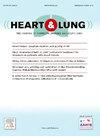Relationship between older coronary heart disease patients’ phase II cardiac rehabilitation intentions, illness perceptions, and family caregivers’ illness perceptions
IF 2.4
4区 医学
Q2 CARDIAC & CARDIOVASCULAR SYSTEMS
引用次数: 0
Abstract
Background
Intention is an important factor in encouraging patients to receive cardiac rehabilitation. Illness perceptions of patients and individuals around them, such as family caregivers, may influence intention. However, no study has explored how family caregivers’ illness perceptions enhance older coronary heart disease (CHD) patients’ phase II cardiac rehabilitation intentions.
Objectives
To describe older CHD patients’ phase II cardiac rehabilitation intentions and their relationship with family caregivers’ illness perceptions and to examine the mediating role of patients’ illness perceptions.
Methods
A descriptive cross-sectional study was conducted among 202 older CHD patient‒family caregiver dyads. The Chinese versions of the Revised Illness Perception Questionnaire, Willingness to Participate in Cardiac Rehabilitation Questionnaire (WPCRQ), and Cardiac Rehabilitation Inventory (CRI) were adopted. Data analysis included descriptive statistics, Pearson correlations, and structural equation modeling. Reporting followed the STROBE checklist.
Results
Patients were 69.81 years and mostly male (64.85 %); family caregivers were 52.58 years and mostly female (55.94 %). Family caregivers’ personal control had a direct effect on patients’ phase II cardiac rehabilitation intentions (βWPCRQ = -0.217, βCRI = -0.228; P = 0.001). Family caregivers’ personal control, treatment control, and timeline acute/chronic had indirect effects on patients’ cardiac rehabilitation intentions through patients’ corresponding dimensions of illness perceptions (|β|WPCRQ = 0.086∼0.098, |β|CRI = 0.062∼0.097; P < 0.05).
Conclusion
Family caregivers’ illness perceptions can affect patients’ phase II cardiac rehabilitation intentions directly and indirectly through patients’ illness perceptions. Interventions targeting illness perceptions in both older CHD patients and their family caregivers could be provided to improve patients’ phase II cardiac rehabilitation intentions.
老年冠心病患者II期心脏康复意愿、疾病认知与家庭照顾者疾病认知的关系
背景:意愿是促使患者接受心脏康复的重要因素。患者及其周围个体(如家庭照顾者)的疾病感知可能会影响意愿。然而,没有研究探讨家庭照顾者的疾病认知如何增强老年冠心病(CHD)患者的II期心脏康复意愿。目的:探讨老年冠心病患者的二期心脏康复意向及其与家庭照顾者疾病感知的关系,并探讨患者疾病感知的中介作用。方法:对202例老年冠心病患者-家庭照顾者进行描述性横断面研究。采用中文版的疾病认知问卷、心脏康复参与意愿问卷(WPCRQ)和心脏康复量表(CRI)。数据分析包括描述性统计、Pearson相关性和结构方程模型。报告遵循STROBE检查表。结果:患者年龄69.81岁,男性居多(64.85%);家庭照顾者年龄为52.58岁,以女性为主(55.94%)。家庭照顾者的个人控制对患者II期心脏康复意愿有直接影响(βWPCRQ = -0.217, βCRI = -0.228;P = 0.001)。家庭照顾者的个人控制、治疗控制和时间急/慢性通过患者相应的疾病感知维度间接影响患者的心脏康复意愿(|β|WPCRQ = 0.086 ~ 0.098, |β|CRI = 0.062 ~ 0.097;P < 0.05)。结论:家庭照顾者疾病感知通过患者疾病感知直接或间接影响患者二期心脏康复意愿。针对老年冠心病患者及其家庭照顾者疾病认知的干预措施可以提高患者的II期心脏康复意愿。
本文章由计算机程序翻译,如有差异,请以英文原文为准。
求助全文
约1分钟内获得全文
求助全文
来源期刊

Heart & Lung
医学-呼吸系统
CiteScore
4.60
自引率
3.60%
发文量
184
审稿时长
35 days
期刊介绍:
Heart & Lung: The Journal of Cardiopulmonary and Acute Care, the official publication of The American Association of Heart Failure Nurses, presents original, peer-reviewed articles on techniques, advances, investigations, and observations related to the care of patients with acute and critical illness and patients with chronic cardiac or pulmonary disorders.
The Journal''s acute care articles focus on the care of hospitalized patients, including those in the critical and acute care settings. Because most patients who are hospitalized in acute and critical care settings have chronic conditions, we are also interested in the chronically critically ill, the care of patients with chronic cardiopulmonary disorders, their rehabilitation, and disease prevention. The Journal''s heart failure articles focus on all aspects of the care of patients with this condition. Manuscripts that are relevant to populations across the human lifespan are welcome.
 求助内容:
求助内容: 应助结果提醒方式:
应助结果提醒方式:


